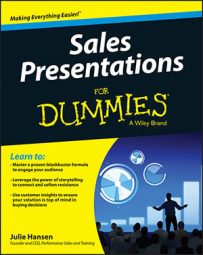You have more ways to open a presentation than Beyoncé has wardrobe changes, however not all are good choices. Successful openings share certain core qualities, including the following:
Cutting to the chase: The chase is that point in your presentation that makes your audience sit up and pay attention. It eliminates unnecessary filler material that adds little in value and wastes precious time. What cutting to the chase does do is gain your audience's interest early on by zeroing in on a key issue, providing an insight, or introducing a benefit.
For example, think about where movies start. Does the director thank you for coming and braving the traffic, give you a backstory on why he made the movie, or describe where the characters went to school? No! Movies start with the car chase or the lovers meeting or some type of compelling action in order to grab the audience's attention. If this is your goal, you must also cut to the chase.
Providing relevance: Whatever you use to open your presentation, whether it's an insight, a quote, or a story, make sure that you quickly and clearly tie it to your topic. There's no quicker way to alienate your audience than to pull an opening bait and switch on them. Starting off with a cute story about your dog that has nothing to do with your presentation misses the mark entirely. Don't make your audience work too hard to make the connection.
Establishing value: Busy prospects hate to have their time wasted and as much as you need to engage and connect, you have to remember why you were invited to the dance in the first place — to provide value. This is especially critical with C-level executives (high ranking members of a corporation whose titles often start with "C" — CEO, CIO, CFO). Fairly quickly in your opening, you need to let your prospect know what value you're going to add to his organization. Rather than listing all of your benefits, highlight a path to your prospect's overall objective. That way he can be confident that he's in good hands.
Setting expectations: An interactive presentation needs to quickly introduce interaction. A challenging presentation needs to challenge. Your audience will take the lead from you on, not just the topic or tone, but things like, "What type of participation is required?" and "How closely do I need to pay attention?" Your opening should be congruent with the rest of your presentation or you may confuse your audience and damage your credibility.
Creating anticipation: Think of your opening as a movie trailer where the goal is to give the audience just enough information to shell out money for a ticket. In the same way, the goal of the opening is to intrigue your audience so they will be motivated to see the rest of your presentation. You've probably seen a preview where they spell out the entire movie for you. Who needs to buy a ticket after that? Getting your audience excited about what's to come is great, but hold back a few plot twists to keep them in their seats.
Being succinct: No matter how compelling your opening, your audience will lose patience and interest if it drags on too long. Shoot for two to three minutes — about the length of time you can expect to hold a prospect's attention before getting into the meat of the subject matter. That's also the length of time of commercial breaks, popular songs, and YouTube videos. That being said, if there's any chance your opening is even slightly less entertaining than the latest YouTube sensation you're probably safest to stay under three minutes.
Focusing on one thing: Most experts agree on having one central idea as the core of your message in order to increase recall. For instance, imagine your prospect is telling his superior about your presentation the next day. What is the one thing you want to be sure he gets across? Of course, it's ideal if he remembers everything, but that's highly unlikely. Many presentations fail by trying to convey too much too soon so that nothing is particularly memorable.
The average American is exposed to 3,000 messages each day, so you need to focus your efforts on getting that one key message to stick rather than spreading it out over half a dozen that will get lost. Depending upon what your goals are, your one thing may be based on providing value, creating a sense of urgency, or reassuring your prospect that you're the right choice. Read more about creating your one thing in the next section.
You may be thinking, "That's a lot to accomplish for such a small percentage of my presentation," and you're right. Yet you must master the opening if you want to give your proposal the best possible chance for success.

